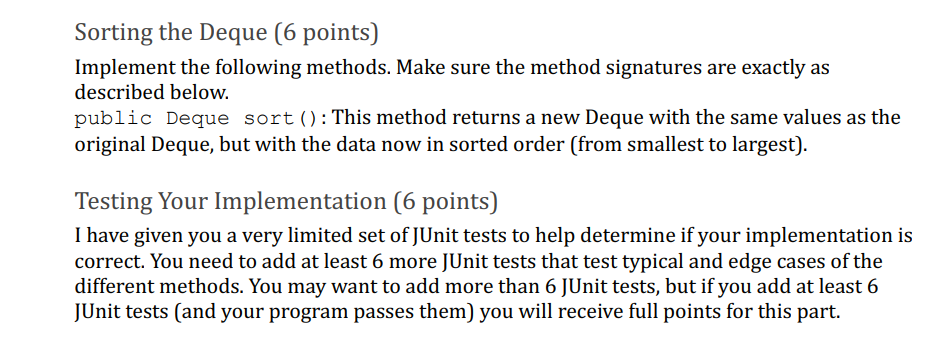package deque; import java.util.ArrayList; import java.util.NoSuchElementException; public class Deque { /* * Nested inner class, that holds the Nodes of the Deque */ static class

package deque;
import java.util.ArrayList; import java.util.NoSuchElementException;
public class Deque { /* * Nested inner class, that holds the Nodes of the Deque */ static class Node { int data; Node next; Node prev; public Node(int i) { data = i; next = null; prev = null; } } Node head; //front of the Deque Node tail; //back of the Deque public Deque() { head = null; tail = null; } /* * Returns true if the Deque is empty (contains no Nodes). Returns true otherwise. */ public boolean isEmpty() { return head==null&&tail==null; } /* * Converts an Deque to an ArrayList. * This method is useful for testing. */ public ArrayList
}
Sorting the Deque (6 points) Implement the following methods. Make sure the method signatures are exactly as described below. public Deque sort (): This method returns a new Deque with the same values as the original Deque, but with the data now in sorted order (from smallest to largest). Testing Your Implementation (6 points) I have given you a very limited set of JUnit tests to help determine if your implementation is correct. You need to add at least 6 more JUnit tests that test typical and edge cases of the different methods. You may want to add more than 6 JUnit tests, but if you add at least 6 JUnit tests (and your program passes them) you will receive full points for this partStep by Step Solution
There are 3 Steps involved in it
Step: 1

See step-by-step solutions with expert insights and AI powered tools for academic success
Step: 2

Step: 3

Ace Your Homework with AI
Get the answers you need in no time with our AI-driven, step-by-step assistance
Get Started


